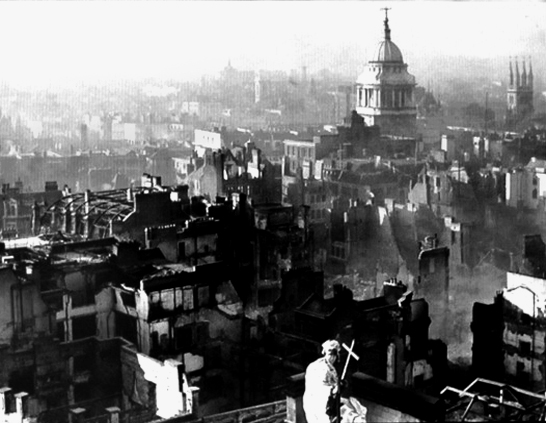
The V-1 was the first of the so-called "Vengeance weapons" series (V-weapons or Vergeltungswaffen) deployed for the terror bombing of London. It was developed at Peenemünde Army Research Center in 1939 by the Nazi GermanLuftwaffe at the beginning of the Second World War, and during initial development was known by the codename "Cherry Stone". Because of its limited range, the thousands of V-1 missiles launched into England were fired from launch facilities along the French (Pas-de-Calais) and Dutch coasts. The Wehrmacht first launched the V-1s against London on 13 June 1944, one week after (and prompted by) the successful Allied landings in France. At peak, more than one hundred V-1s a day were fired at south-east England, 9,521 in total, decreasing in number as sites were overrun until October 1944, when the last V-1 site in range of Britain was overrun by Allied forces. After this, the Germans directed V-1 at the port of Antwerp and at other targets in Belgium, launching a further 2,448 V-1s. The attacks stopped only a month before the war in Europe ended, when the last launch site in the Low Countries was overrun on 29 March 1945.
As part of operations against the V-1, the British operated an arrangement of air defenses, including anti-aircraft guns and fighter aircraft, to intercept the bombs before they reached their targets, while the launch sites and underground storage depots became targets for Allied attacks including strategic bombing.
In 1944, a number of tests of this weapon were conducted in Tornio, Finland. According to multiple soldiers, a small "plane"-like bomb with wings fell off of a German plane. Another V-1 was launched which flew over the Finnish soldiers' lines. The second bomb suddenly stopped its engine and fell steeply down, exploding and leaving a crater around 20–30#meters wide. The V-1 flying bomb was referred by Finnish soldiers as a "Flying Torpedo" due to its resemblance to one from afar.
In 1935, Paul Schmidt and Professor Georg Hans Madelung submitted a design to the Luftwaffe for a flying bomb. It was an innovative design that used a jet engine, a pulse-jet engine, while previous work dating back to 1915 by Sperry Gyroscope, relied on propellers. While employed by the Argus Motoren company, Fritz Gosslau developed a remote-controlled target drone, the FZG 43 (Flakzielgerat-43). In October 1939, Argus proposed Fernfeuer, a remote-controlled aircraft carrying a payload of one ton, that could return to base after releasing its bomb. Argus worked in co-operation with C. Lorenz AG and Arado Flugzeugwerke to develop the project. However, once again, the Luftwaffe declined to award a development contract. In 1940, Schmidt and Argus began cooperating, integrating Schmidt's shutter system with Argus' atomized fuel injection. Tests began in January 1941, and the first flight made on 30 April 1941 with a Gotha Go 145. On 27 February 1942, Gosslau and Robert Lusser sketched out the design of an aircraft with the pulse-jet above the tail, the basis for the future V-1.
Lusser produced a preliminary design in April 1942, P35 Efurt, which used gyroscopes. When submitted to the Luftwaffe on 5 June 1942, the specifications included a range of 186 miles, a speed of 435 mph, and capable of delivering a half ton warhead. Project Fieseler Fi 103 was approved on 19 June, and assigned code name Kirschkern and cover name Flakzielgerat 76 (FZG-76). Flight tests were conducted at the Luftwaffe's Erprobungsstelle coastal test centre at Karlshagen, Peenemünde-West.
Milch awarded Argus the contract for the engine, Fieseler the airframe, and Askania the guidance system. By 30 August, Fieseler had completed the first fuselage, and the first flight of the Fi 103 V7 took place on 10 December 1942, when it was airdropped by a Fw 200. Then on Christmas Eve, the V-1 flew 1000 yards, for about a minute, after a ground launch. On 26 May 1943, Germany decided to put both the V-1 and the V-2 into production. In July 1943, the V-1 flew 245 kilometers and impacted within a kilometer of its target.
The V-1 was named by Das Reich journalist Hans Schwarz Van Berkl in June 1944 with Hitler's approval.

The V-1 was designed under the codename Kirschkern (cherry stone) by Lusser and Gosslau, with a fuselage constructed mainly of welded sheet steel and wings built of plywood. The simple, Argus-built pulsejet engine pulsed 50 times per second, and the characteristic buzzing sound gave rise to the colloquial names "buzz bomb" or "doodlebug" (a common name for a wide variety of flying insects). The Argus pulsejet's major components included the nacelle, fuel jets, flap valve grid, mixing chamber venturi, tail pipe and spark plug. Compressed air forced gasoline, from the 640 liter fuel tank, through the fuel jets, consisting of three banks of atomizers with three nozzles each. Argus' pressurized fuel system negated the need for a fuel pump. These nine atomizing nozzles were in front of the air inlet valve system where it mixed with air before entering the chamber. A throttle valve, connected to altitude and ram pressure instruments, controlled fuel flow.
Schmidt's spring-controlled flap valve system provided an efficient straight path for incoming air. The flaps momentarily closed after each explosion, the resultant gas was partially compressed by the ventures, and the tapered tail pipe further compressed the exhaust gases creating thrust. The operation proceeded at a rate of 42 cycles per second.
Beginning in January 1941, the V-1's pulsejet engine was also tested on a variety of craft, including automobiles and an experimental attack boat known as the "Tornado". The unsuccessful prototype was a version of a Sprengboot, in which a boat loaded with explosives was steered towards a target ship and the pilot would leap out of the back at the last moment. The Tornado was assembled from surplus seaplane hulls connected in catamaran fashion with a small pilot cabin on the crossbeams. The Tornado prototype was a noisy underperformer and was abandoned in favor of more conventional piston-engine craft.
The engine made its first flight aboard a Gotha Go 145 on 30 April 1941

The V-1 guidance system used a simple autopilot developed by Askania in Berlin to regulate altitude and airspeed a pair of gyroscopes controlled yaw and pitch, while azimuth was maintained by a magnetic compass. Altitude was maintained by a barometric device. Two spherical tanks contained compressed air at 900 pounds per square inch, that drove the gyros, operated the pneumatic servo-motors controlling the rudder and elevator, and pressurized the fuel system.
The magnetic compass was located near the front of the V1, within a wooden sphere. Just before launch, the V1 would be suspended inside the Compass Swinging Building (Richthaus). There the compass was corrected for magnetic variance and magnetic deviation.
The RLM (Reichsluftfahrtministerium) at first planned to use a radio control system with the V-1 for precision attacks, but the government decided instead to use the missile against London. However, some flying bombs were equipped with a basic radio transmitter operating in the range of 340-450 kHz. Once over the channel, the radio would be switched on by the vane counter, and a 400-foot aerial deployed. A coded Morse signal, unique to each V1 site, transmitted the route, and impact zone once the radio stopped transmitting.
An odometer driven by a vane anemometer on the nose determined when the target area had been reached, accurately enough for area bombing. Before launch, it was set to count backwards from a value that would reach zero upon arrival at the target in the prevailing wind conditions. As the missile flew, the airflow turned the propeller, and every 30 rotations of the propeller counted down one number on the odometer. This odometer triggered the arming of the warhead after about 60 km (37 mi). When the count reached zero, two detonating bolts were fired. Two spoilers on the elevator were released, the linkage between the elevator and servo was jammed, and a guillotine device cut off the control hoses to the rudder servo, setting the rudder in neutral. These actions put the V-1 into a steep dive. While this was originally intended to be a power dive, in practice the dive caused the fuel flow to cease, which stopped the engine. The sudden silence after the buzzing alerted listeners of the impending impact.
Initially, V-1s landed within a circle 19 miles (31 kilometers) in diameter, but by the end of the war, accuracy had been improved to about 7 miles (11 kilometers), which was comparable to the V-2 rocket.
The warhead consisted of 850 kg of Amatol, 52A+ high-grade blast-effective explosive with three fuses. An electrical fuse could be triggered by nose or belly impact. Another fuse was a slow-acting mechanical fuse allowing deeper penetration into the ground, regardless of the altitude. The third fuse was a delayed action fuse, set to go off two hours after launch.
The purpose of the third fuse was to avoid the risk of this secret weapon being examined by the British. It was too short to be any sort of booby trap, but was instead meant to destroy the weapon if a soft landing had not triggered the impact fuses. These fusing systems were very reliable, and there were almost no dud V-1s recovered.
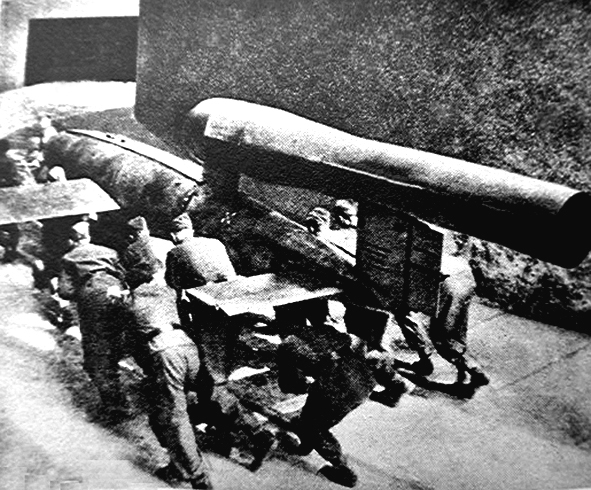

Ground-launched V-1s were propelled up an inclined launch ramp by an apparatus known as a Dampferzeuger ("steam generator"), in which steam was generated when hydrogen peroxide T-Stoff) was mixed with sodium permanganate (Z-Stoff). Designed by Helmut Walter Kommanditgesellschaft, the WR 2.3 Schlitzrohrschleuder consisted of a small gas generator trailer, where the T-Stoff and Z-Stoff combined, generating high-pressure steam that was fed into a tube in the launch rail box.
A piston in the tube, connected underneath the missile, was propelled forward by the steam. This enabled the missile to become airborne with a strong enough air-flow allowing the pulse-jet engine to operate. The launch rail was 49 m (160 ft) long, consisting of 8 modular sections 6 m long, and a muzzle brake. Production of the Walter catapult began in January 1944.
The Walter catapult accelerated the V-1 to a launch speed of 200 mph, well above the needed minimum operational speed of 150 mph. The V-1 made British landfall at 340 mph, but accelerated to 400 mph over London, as its 150 gallons of fuel burned off.
On 18 June 1943, Hermann Göring decided on launching the V-1, using the Walter catapult, in both large launch bunkers, called Wasserwerk, and lighter installations, called the Stellungsystem. The Wasserwerk bunker measured 215m long, 36m wide, and 10m high. Four were initially to be built: Wasserwerk Desvres, Wasserwerk St. Pol, Wasserwerk Valognes, and Wasserwerk Cherbourg. Stellungsystem-I was to be operated by Flak Regiment 155(W), with 4 launch battalions, each having 4 launchers, and located in the Pas-de-Calais region. Stellungsystem-II, with 32 sites, was to act as a reserve unit. Stellungsystem-I and II had nine batteries manned by February 1944. Stellungsystem=III, operated by FR 255(W), was to be organized in the spring of 1944, and located between Rouen and Caen. The Stellungsystem locations included distinctive catapult walls pointed towards London, several "J"-shaped stowage buildings referred to as "ski" buildings, and a compass correction building. In the spring of 1944, Oberst Schmalschläger had developed a more simplified launching site, called Einsatz Stellungen. Less conspicuous, 80 launch sites and 16 support sites were located from Calais to Normandy. Each site took only 2 weeks to construct, using 40 men, and the Walter catapult only took 7–8 days to erect, when the time was ready to make it operational.
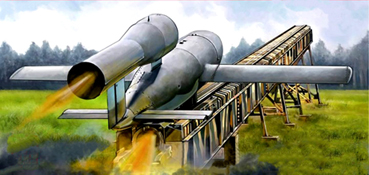
Once near the launch ramp, the wing spar and wings were attached and the missile was slid off the loading trolley, Zubringerwagen, onto the launch ramp. The ramp catapult was powered by the Dampferzeuger trolley. The pulse-jet engine was started by the Anlassgerät, which provided compressed air for the engine intake, and electrical connection to the engine spark plug, and autopilot. The Bosch spark plug was only needed to start the engine, while residual flame ignited further mixtures of gasoline and air, and the engine would be at full power after 7 seconds. The catapult would then accelerate the bomb above its stall speed of 200 mph, and ensuring sufficient ram air.
Mass production of the FZG-76 did not start until the spring of 1944, and FR 155(W) was not equipped until late May 1944. Operation Eisbär, the missile attacks on London, commenced on 12 June. However, the four launch battalions could only operate from the Pas-de-Calais area, amounting to only 72 launchers. They had been supplied with missiles, Walter catapults, fuel, and other associated equipment since D-Day. None of the 9 missiles launched on the 12th reached England, while only 4 did so on the 13th.
The next attempt to start the attack occurred on the night of 15/16 June, when 144 reached England, of which 73 struck London, while 53 struck Portsmouth and Southampton. Damage was widespread and Eisenhower ordered attacks on the V-1 sites as a priority. Operation Cobra forced the retreat from the French launch sites in August, with the last battalion leaving on 29 August. Operation Donnerschlag would begin from Germany on 21 October 1944.

On 13 June, the first V-1 struck London next to the railway bridge on Grove road, Mile End, which now carries this English Heritage plaque. Eight civilians were killed in the blast.
The first complete V-1 airframe was delivered on 30 August 1942, and after the first complete As.109-014 was delivered in September, the first glide test flight was on 28 October 1942 at Peenemünde, from under a Focke-Wulf Fw 200. The first powered trial was on 10 December, launched from beneath an He 111.

The LXV Armeekorps z.b.V. formed during the last days of November 1943 in France commanded by General der Artillerie z.V. Erich Heinemann was responsible for the operational use of V-1.
The conventional launch sites could theoretically launch about 15 V-1s per day, but this rate was difficult to achieve on a consistent basis; the maximum rate achieved was 18. Overall, only about 25% of the V-1s hit their targets, the majority being lost because of a combination of defensive measures, mechanical unreliability or guidance errors. With the capture or destruction of the launch facilities used to attack England, the V-1s were employed in attacks against strategic points in Belgium, primarily the port of Antwerp.
Launches against Britain were met by a variety of countermeasures, including barrage balloons and aircraft such as the Hawker Tempest and Gloster Meteor. These measures were so successful that by August 1944 about 80% of V-1s were being destroyed (Although the Meteors were fast enough to catch the V-1s, they suffered from frequent cannon failures, and accounted for only 13). In all, about 1,000 V-1s were destroyed by aircraft.
The intended operational altitude was originally set at 2,750 m (9,000 ft). However, repeated failures of a barometric fuel-pressure regulator led to it being changed in May 1944, halving the operational height, thereby bringing V-1s into range of the Bofors guns commonly used by Allied AA units.
The trial versions of the V-1 were air-launched. Most operational V-1s were launched from static sites on land, but from July 1944 to January 1945, the Luftwaffe launched approximately 1,176 from modified Heinkel He 111 H-22s of the Luftwaffe's Kampfgeschwader 3 (3rd Bomber Wing, the so-called "Blitz Wing") flying over the North Sea. Apart from the obvious motive of permitting the bombardment campaign to continue after static ground sites on the French coast were lost, air launching gave the Luftwaffe the opportunity to outflank the increasingly effective ground and air defenses put up by the British against the missile. To minimize the associated risks (primarily radar detection), the aircrews developed a tactic called "lo-hi-lo": the He 111s would, upon leaving their airbases and crossing the coast, descend to an exceptionally low altitude. When the launch point was neared, the bombers would swiftly ascend, fire their V-1s, and then rapidly descend again to the previous "wave-top" level for the return flight. Research after the war estimated a 40% failure rate of air-launched V-1s, and the He 111s used in this role were vulnerable to night-fighter attack, as the launch lit up the area around the aircraft for several seconds. The combat potential of air-launched V-1s dwindled during 1944 at about the same rate as that of the ground-launched missiles, as the British gradually took the measure of the weapon and developed increasingly effective defense tactics.
 |
 |
Eventually about 2,000 barrage balloons were deployed, in the hope that V-1s would be destroyed when they struck the balloons' tethering cables. The leading edges of the V-1's wings were fitted with Kuto cable cutters, with fewer than 300 V-1s were known to have been brought down by barrage balloons.
The Defense Committee expressed some doubt as to the ability of the Royal Observer Corps to adequately deal with the new threat, but the ROC's Commandant Air Commodore Finlay Crerar assured the committee that the ROC could again rise to the occasion and prove its alertness and flexibility. He oversaw plans for handling the new threat, codenamed by the RAF and ROC as "Operation Totter".
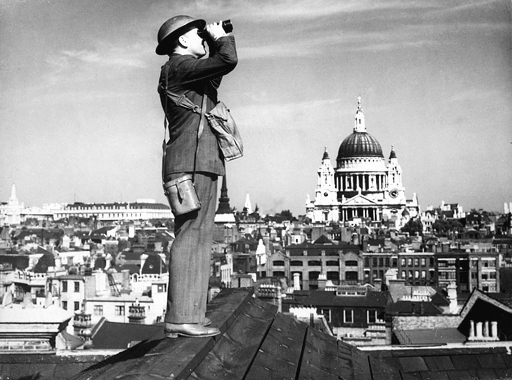
(The image at right might be a composite photograph.)
The average speed of V-1s was 550 km/h (340 mph) and their average altitude was 1,000 m (3,300 ft) to 1,200 m (3,900 ft). Fighter aircraft required excellent low altitude performance to intercept them and enough firepower to ensure that they were destroyed in the air (ideally, also from a sufficient distance, to avoid being damaged by the strong blast) rather than the V-1 crashing to earth and detonating. Most aircraft were too slow to catch a V-1 unless they had a height advantage, allowing them to gain speed by diving on their target.
When V-1 attacks began in mid-June 1944, the only aircraft with the low-altitude speed to be effective against it was the Hawker Tempest. Fewer than 30 Tempests were available. They were assigned to No. 150 Wing RAF. Early attempts to intercept and destroy V-1s often failed, but improved techniques soon emerged. These included using the airflow over an interceptor's wing to raise one wing of the V-1, by sliding the wingtip to within 6 in (15 cm) of the lower surface of the V-1's wing. If properly executed, this maneuver would tip the V-1's wing up, over-riding the gyro and sending the V-1 into an out-of-control dive. At least sixteen V-1s were destroyed this way (the first by a P-51 piloted by Major R. E. Turner of 356th Fighter Squadron on 18 June). (First to physically tip a V1 bomb was Ken Collier, 91 Squadron, in a Spitfire MkIVX. He scored 7 V1 victories and was later killed in action.)
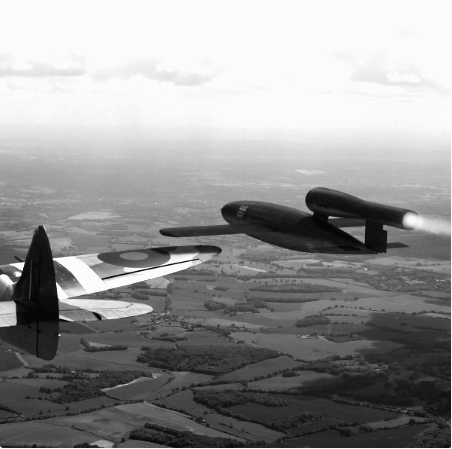
Questions remain on the photograph at the left. It could also have been Photoshopped by someone. Also two descriptions of what the moment shows.
The Tempest fleet was built up to over 100 aircraft by September, and during the short summer nights the Tempests shared defensive duty with de Havilland Mosquitoes. Specially modified P-47M Thunderbolts were also pressed into service against the V-1s; they had boosted engines (2800 hp) and had half their 0.5in (12.7 mm) machine guns and half their fuel tanks, all external fittings and all their armor plate removed. In addition, North American P-51 Mustangs and Griffon-engine Super marine Spitfire Mk XIVs were tuned to make them fast enough, At night airborne radar was not needed, as the V-1 engine could be heard from 10 mi (16 km) away or more and the exhaust plume was visible from a long distance. Wing Commander Roland Beamont had the 20 mm cannon on his Tempest adjusted to converge at 300 yd (270 m) ahead. This was so successful that all other aircraft in 150 Wing were thus modified.
The anti-V-1 sorties by fighters were known as Diver patrols "https://en.wikipedia.org/wiki/Operation_Diver"" (after "Diver", the codename used by the Royal Observer Corps for V-1 sightings). Attacking a V-1 was dangerous: machine warhead, the explosion could destroy the attacker guns had little effect on the V-1's sheet steel structure, and if a cannon shell detonated the warhead, the explosion could destroy the attacker.
In daylight, V-1 chases were chaotic and often unsuccessful until a special defense zone was declared between London and the coast, in which only the fastest fighters were permitted. The first interception of a V-1 was by F/L J. G. Musgrave with a No. 605 Squadron RAF Mosquito night fighter on the night of 14/15 June 1944. As daylight grew stronger after the night attack, a Spitfire was seen to follow closely behind a V-1 over Chislehurst and Lewisham. Between June and 5 September 1944, a handful of 150 Wing Tempests shot down 638 flying bombs, with No. 3 Squadron RAF alone claiming 305. One Tempest pilot, Squadron Leader Joseph Berry (501 Squadron), shot down 59 V-1s, the Belgian ace Squadron Leader Remy Van Lierde (164 Squadron) destroyed 44 (with a further nine shared) and W/C Roland Beamont destroyed 31.
The first bomb disposal officer to defuse an unexploded V-1 was John Pilkington Hudson in 1944. He was born on 24 July 1910 in Buxton, Derbyshire, to William Arthur Hudson (1884–1976), a post-office employee from Cheshire, and his wife Bertha, née Pilkington (1887–1969), daughter of a local coal merchant. He had a younger sister, Margaret. He attended New Mills Secondary School, but left at 16 to work in a garden nursery his father had started at Chapel-en-le-Frith. Nonetheless, he showed an early interest in physics.
After a one-year course in horticulture, he went on to take a University of London external degree in the subject at the Midland Agricultural and Dairy College in Sutton Bonington, and briefly lectured there in 1935. In 1936 he married Mary Gretta Heath (1910–1989), a dairy chemist, daughter of William Nathaniel Heath, farmer. They had two sons, Colin and Richard. They lived in Plumpton, East Sussex for three years while Hudson worked as an East Sussex County Council horticultural adviser.
Shortly before the Second World War, Hudson joined the Territorial Army. He immediately saw action in France and was evacuated from Dunkirk. He was then assigned to bomb disposal with the Royal Engineers, heading a group in Sheffield. There his scientific acumen stood him in good stead and he was summoned to work on new defusing methods in London, with the rank of major.
Hudson's war career included several months in the United States liaising with bomb disposal experts there. He was appointed a Member of the Order of the British Empire. He was awarded a George Medal in 1943 for disabling the first anti-tamper Y bomb fuse on 24 January 1943, six days after an intact fuse had first been recovered. According to an obituarist:
He returned to London [from the States] just in time to tackle a new type of enemy battery-powered fuse. It could be paralysed by liquid oxygen, which deadened the batteries, but the resulting extremely low temperature would crack the bomb-casing, setting off another type of fuse. Working on a half-tonne UXB (Un Exploded Bomb) near the Albert bridge... he neutralized the main fuse, and heard the crack but no explosion. He coolly climbed down into the crater and bodily removed the fuse.... For this he was awarded his first George Medal in 1943.
In 1944 he received a Bar to his George Medal for defusing the first V1 flying bomb or "doodlebug" to land intact. The nature of his war work remained unknown to friends until a Channel 4 UK television series on defusing was shown in 2001.


To adjust and correct settings in the V-1 guidance system, the Germans needed to know where the V-1s were impacting. Therefore, German intelligence was requested to obtain this impact data from their agents in Britain. However, all German agents in Britain had been turned, and were acting as double agents under British control.
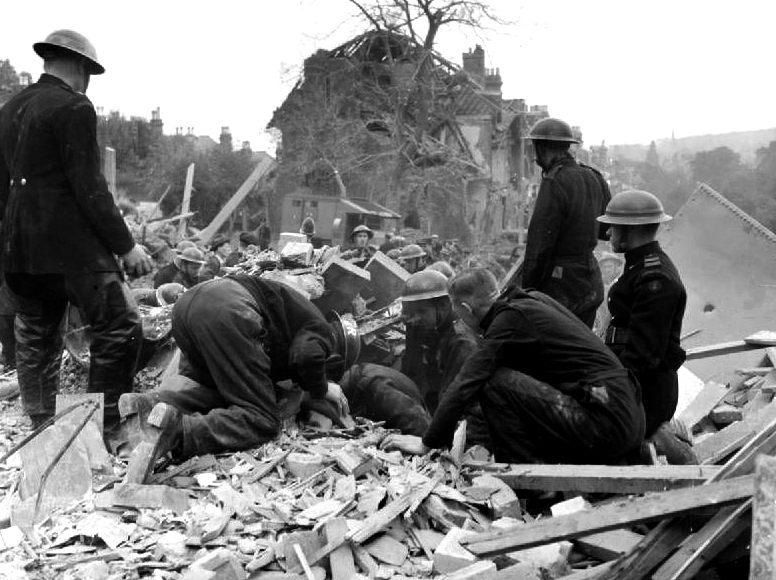
However, there was no plausible reason why the double agents could not supply accurate data; the impacts would be common knowledge amongst Londoners and very likely reported in the press, which the Germans had ready access to through the neutral nations. In addition, as John Cecil Masterman, chairman of the Twenty Committee, commented, "If, for example, St Paul's Cathedral were hit, it was useless and harmful to report that the bomb had descended upon a cinema in Islington, since the truth would inevitably get through to Germany ..."
While the British decided how to react, Pujol played for time. On 18 June it was decided that the double agents would report the damage caused by V-1s fairly accurately and minimize the effect they had on civilian morale. It was also decided that Pujol should avoid giving the times of impacts, and should mostly report on those which occurred in the north west of London, to give the impression to the Germans that they were overshooting the target area.
While Pujol downplayed the extent of V-1 damage, trouble came from Ostro, an Abwehr agent in Lisbon who pretended to have agents reporting from London. He told the Germans that London had been devastated and had been mostly evacuated as a result of enormous casualties. The Germans could not perform aerial reconnaissance of London, and believed his damage reports in preference to Pujol's. They thought that the Allies would make every effort to destroy the V-1 launch sites in France. They also accepted Ostro's impact reports. Due to Ultra, however, the Allies read his messages and adjusted for them.
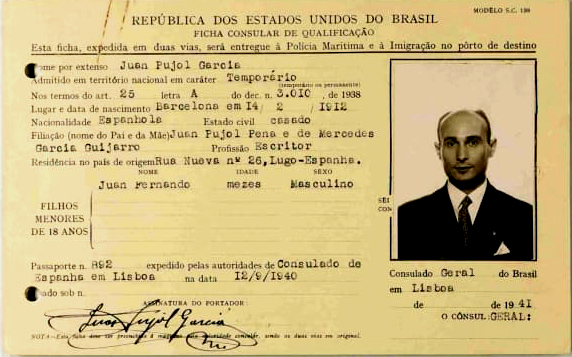
Biography of Juan Pujol:
After World War II, a critical MI5 spy named Juan Pujol Garcia faked his own death, and kept it secret for almost four decades. And that's not even the most interesting thing about him.
Pujol was a veteran of the Spanish Civil War who had come to loathe totalitarianism, both in Francisco Franco and Adolf Hitler. When Britain went to war with Germany in 1939, he was determined to join the British war effort as a spy against Germany; so determined that he wasn't deterred when British officers turned him down because he didn't have any connections or credentials. Instead, he formulated a plan to pad his resume while aiding the war effort.
Francisco Franco and Adolf Hitler. When Britain went to war with Germany in 1939, he was determined to join the British war effort as a spy against Germany; so determined that he wasn't deterred when British officers turned him down because he didn't have any connections or credentials. Instead, he formulated a plan to pad his resume while aiding the war effort.
Posing as a Spanish official who was flying to London, Pujol made contact with Nazi officials in Madrid and told them that he was interested in spying on Britain for the Third Reich. After that, he began sending the Nazis fabricated information that they thought was from London, but which was actually fed from Lisbon and Madrid. Essentially, Pujol became a rogue double-agent whom Britain didn’t even know it had.
Though Pujol sent Germany false reports, he used lots of factual information to make them seem legitimate, says Stephan Talty, author of Agent Garbo: The Brilliant, Eccentric Secret Agent Who Tricked Hitler and Saved D-Day and a about a Cold War rescue mission.
He was really gathering these sort of factoids from different encyclopedias, and even from advertisements he saw and placards he saw in the street,” Talty says. “So he was a complete amateur, but he was able to sort of built up enough of a portfolio to finally approach the British.
That isn’t to say he didn’t make some mistakes. Britain’s domestic intelligence agency, MI5, notes on its website that Pujol once told Germans that on a visit to Glasgow, Scotland, he found men who “would do anything for a litre of wine.” Evidently, the Nazis didn’t catch that he should’ve said “beer” or “whiskey” (in 2015, the Telegraph declared “Scotland’s first wine branded ‘undrinkable’ by the Telegraph declared “Scotland’s first wine branded ‘undrinkable’ by critics”.
In 1942, Pujol again approached British officials about becoming a double-agent by showing them that, in fact, he already was one. Unbeknownst to him, British operatives had already realized that a secret spy was sending information to Germany from Portugal and Spain, but didn’t know who that spy was. When Pujol revealed himself, they brought him to London to work for MI5.
The Nazis continued to think of Pujol as an important spy throughout the war. They never discovered that he was a double agent, despite the fact that a lot of his information was incorrect.
“I think the Germans felt that no one could really fake this much information and this many different characters,” Talty says, referencing the 27 imaginary spies that Pujol told Germans he had recruited to feed him information (Pujol’s MI5 codename was “Agent Garbo” because he was such a good actor). “[The Germans] also felt that if they cut him off or if they doubted him even, they were not going to just lose one agent, they were going lose a network.”
In his most famous deception, Pujol told the Nazis that news they’d heard about a planned invasion of Normandy was fake. Of course, this wasn’t true, and as a result the Nazis were unprepared for the Allies’ successful D-Day invasion.
After the European war ended in 1945, Pujol continued to work for MI5 to investigate whether Germany had any plans to resurrect a sort of Fourth Reich. After this, Pujol wanted to get out of Europe and away from his memories of the war, so he moved to Venezuela. But because many former Nazis had also chosen Venezuela as a place to flee from their crimes, Pujol figured it would be safer for him there if everybody thought he was dead.
In 1948, he called Tommy Harris, who’d been his handler at MI5, and instructed him to tell everyone that he had died of malaria in Angola. Harris spread this news through the organization, and a year later the British ambassador officially told Spain that he was dead. The news reached Pujol’s first wife and children in Spain. Meanwhile, in Venezuela, Pujol grew a beard and started wearing a distinctive pair of glasses.
Pujol kept his secret until the 1980s, when the British writer Nigel West looked into his life and theorized that he hadn’t died. West tracked down Pujol, who came out of hiding and announced that it was true. He returned to Europe and reconnected with his ex-wife, who’d always suspected he was alive, and his very-upset children, who had not.
He died a second—and final—time in 1988, but not before writing a book about his life with West (West is actually the pen name of Rupert Allason, a former member of Parliament who’s been sued several times for libel). Last year, Variety reported that Oscar Isaac will star in a film about his life.
Talty notes that Pujol didn’t have to fake his death for as long as he did. He would have probably been safe from Nazi retaliation had he, for instance, revealed himself in the 1960s. Talty argues that Pujol seemed to be ashamed that he was not able to make a successful career for himself in Venezuela after the war, and that this is part of why he stayed in hiding. In addition, Talty says that Pujol was good at assuming different personas—one of the reasons he was such an unusually good spy in the first place.
“If you read espionage history, so many agents are either trapped into becoming double agents or paid for their work,” Talty says. But that wasn’t the case for Pujol. “He was an idealistic double agent, which is very rare. He did it strictly out of idealism, and I think also to realize himself as the great improvisational actor that he knew he was. It gave him a role that he wanted to play.”
A certain number of the V-1s fired had been fitted with radio transmitters, which had clearly demonstrated a tendency for the V-1 to fall short. Oberst Max Wachtel, commander of Flak Regiment 155 (W), which was responsible for the V-1 offensive, compared the data gathered by the transmitters with the reports obtained through the double agents. He concluded, when faced with the discrepancy between the two sets of data, that there must be a fault with the radio transmitters, as he had been assured that the agents were completely reliable. It was later calculated that if Wachtel had disregarded the agents' reports and relied on the radio data, he would have made the correct adjustments to the V-1's guidance, and casualties might have increased by 50 percent or more.
The policy of diverting V-1 impacts away from central London was initially controversial. The War Cabinet refused to authorize a measure that would increase casualties in any area, even if it reduced casualties elsewhere by greater amounts. It was thought that Churchill would reverse this decision later (he was then away at a conference); but the delay in starting the reports to Germans might be fatal to the deception. So Sir Findlater Stewart of Home Defense Executive took responsibility for starting the deception program immediately, and his action was approved by Churchill when he returned.
By September 1944, the V-1 threat to England was temporarily halted when the launch sites on the French coast were overrun by the advancing Allied armies. 4,261 V-1s had been destroyed by fighters, anti-aircraft fire and barrage balloons. The last enemy action of any kind on British soil occurred on 29 March 1945, when a V-1 struck Datchworth in Hertfordshire.

Unlike the V-2, the V-1 was a cost-effective weapon for the Germans as it forced the Allies to spend heavily on defensive measures and bombers from other targets. More than 25% of Combined Bomber Offensive's bombs in July and August 1944 were used against V-weapon sites, often ineffectively. In early December 1944, American General Clayton Bissell wrote a paper that argued strongly in favor of the V-1 when compared with conventional bombers.
Wright Field technical personnel reverse-engineered the V-1 from the remains of one that had failed to detonate in Britain. The result was the creation of the JB-2 Loon. General Hap Arnold of the United States Army Air Forces was concerned that this weapon could be built of steel and wood, in 2000 man-hours and approximate cost of US$ 600 (in 1943).
To put this figure in perspective, a Boeing B-29 Super fortress cost about 1000 times more, and still about 100 times more when taking into account its 10 times higher payload (20,000 lb compared to 850 kg for V-1) – payload, which cost has to be added (while it is included in V-1 cost) – with the additional drawback of requiring (and putting in danger) 11 flying crew members (which generally are considered to cost far more than the aircraft itself, with costs of recruiting, training, housing, feeding, pensions and pay, equipment, etc.)
| Big Raids and Combined Bomb Tonnage | ||
| City | Tons | Raids |
| London | 18,291 | 71 |
| Liverpool/ Merseyside |
1,957 | 8 |
| Birmingham | 1,852 | 8 |
| Glasgow/ Clydeside |
1,329 | 5 |
| Plymouth | 1,228 | 8 |
| Bristol | 919 | 6 |
| Exeter | 75 | 19 |
| Coventry | 818 | 2 |
| Portsmouth | 687 | 3 |
| Southampton | 647 | 4 |
| Hull | 593 | 3 |
| Manchester | 578 | 3 |
| Belfast | 440 | 2 |
| Sheffield | 355 | 2 |
| Sunderland | 155 | 1 |
| Nottingham | 137 | 1 |
| Cardiff | 115 | 1 |
Worst of all was the terrifying suddenness with which it struck. They couldn’t see it coming. They couldn’t even hear it – until too late. Without warning, the ground trembled as if from a local earthquake and a roaring blast beat on their ear drums, followed by an eerie, rumbling “whoosh”. Most of the people were knocked flat but those close to the explosion were killed or mangled. Twisted fragments of metal littered the area and when the dazed survivors stumbled to the wreckage they found a deep crater, perhaps 30 feet in diameter, from which protruded the finned tail of a curious cylindrical missile the size of a small airplane fuselage.
A shudder rippled through the onlookers. They knew then that the fantastic stratosphere rocket, another monstrous perversion of German science, had paid them a lethal visit. It seemed to be the handiwork of demons – a wingless, self-propelled projectile, which fired into space at supersonic speeds, would plunge at random like a vengeful meteor upon a peaceful countryside or city.
To Allied scientists the new manifestation of indiscriminate warfare – known as V-2 – was a “considerable technical achievement” but less destructive than the Nazis must have hoped it would be. True, numerous civilians were killed and wounded after the bombardment began to rain on England last autumn. And of the 1,100,000 English homes, hospitals, churches and schools reported damaged by “V Bombs” since last June, many were victims of the V-2.
But as to military effectiveness, the V-2 was regarded as no more destructive than V-1, the “buzz bomb” with wings. The V-2 penetrated deep into the earth and thus concentrates much of its damage around its own self-made crater. The V-1, which was cheaper and much less complicated to build, but carried the same amount of explosives (one ton), digs hardly any hole but scatters shrapnel and glass over a greater radius.
Recently, the Germans launched over the Western Front what is believed to be a new type of rocket. This barrage weapon has been called a V-1½ for it is said to combine features of both the V-1 and the V-2.
 |
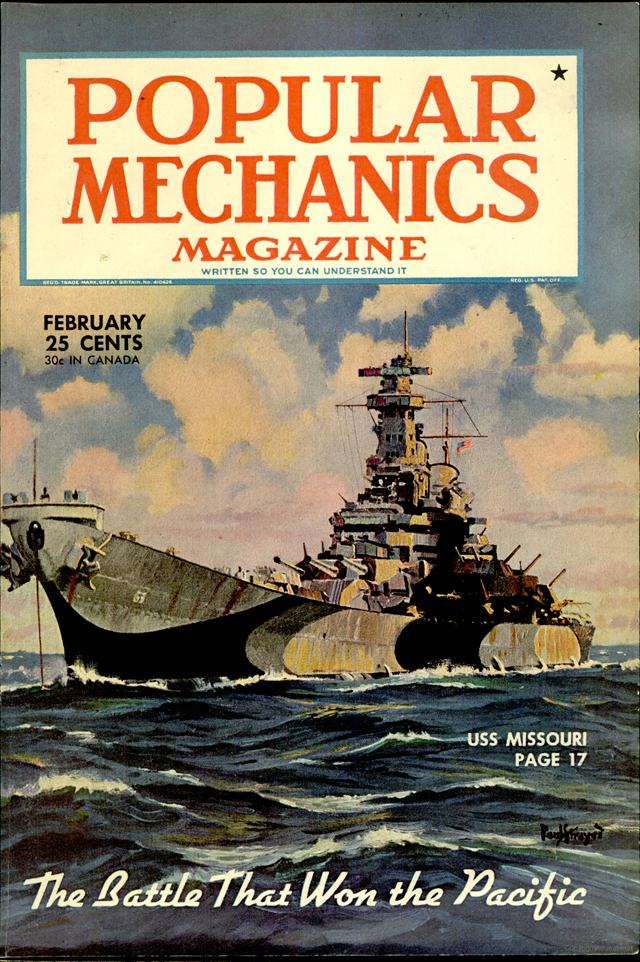 |
…The V1½ in above illustration, is the weirdest- looking of World War II’s surprise weapons. It resembles a metal telegraph pole 46 feet long and five feet in diameter, and it behaves like a gigantic Roman candle gone berserk. Weighing 13½ tons at takeoff, it climbs upward to 70 miles above the earth before it starts its descent. When it strikes, it plows under more than half its length before it is detonated with a noise that can be heard almost 20 miles away.
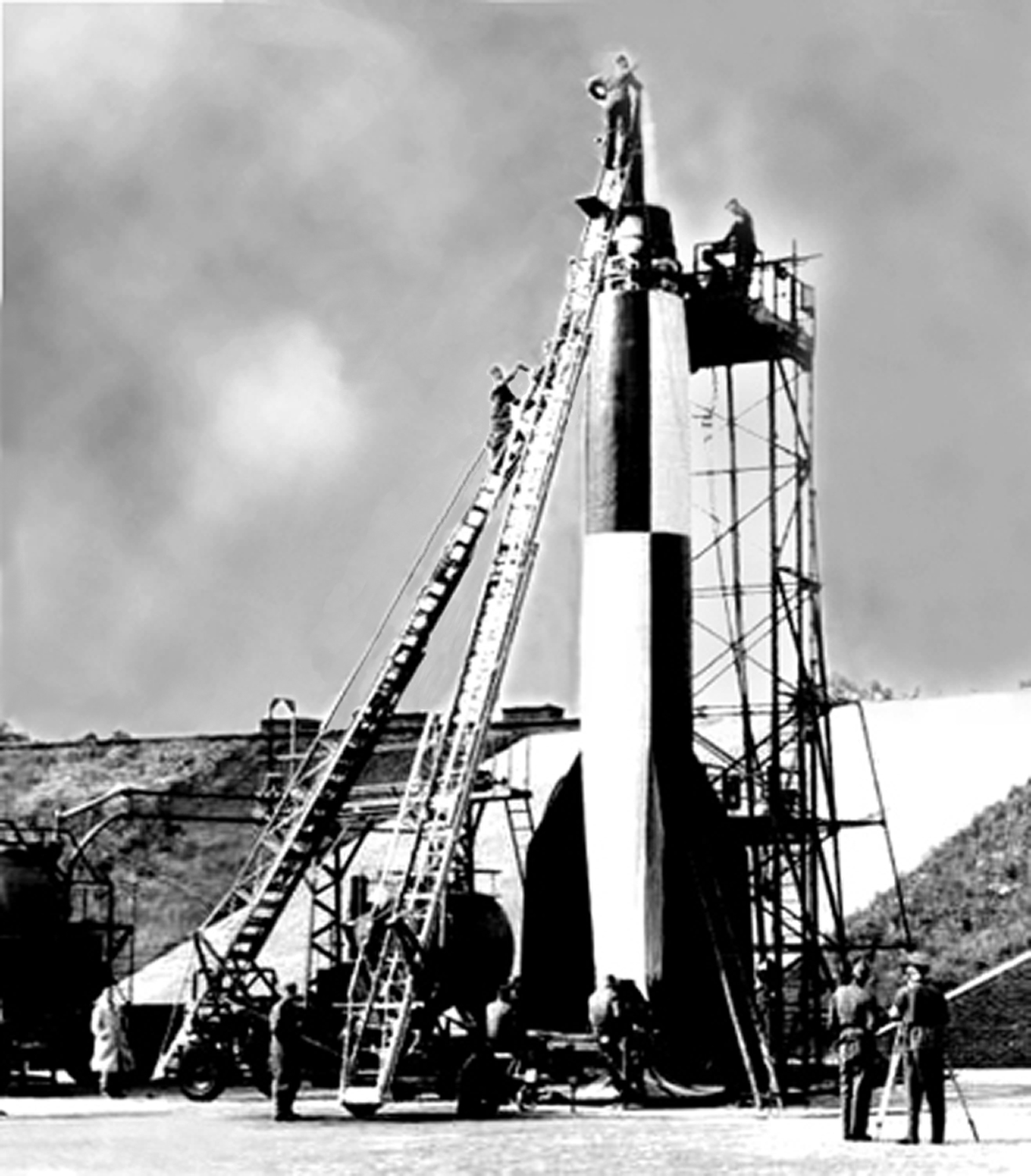
The V-2 is launched in a vertical position from a concrete platform or hard surface, according to British Air Ministry. To keep the fuels from exploding, hydrogen peroxide and potassium permanganate are mixed with the highly explosive combination of alcohol and liquid air. Pipes carry these four liquids into a turbine and pump assembly where they are blended and released under pressure through 18 jets into the forward end of the combustion chamber. The fine spray is ignited electrically from a safe distance and the hot gases rush out through jets at the rear of the chamber.
Unlike the gas turbine method of jet propulsion in airplanes, V-2 does not breathe air but derives all its power from the fuel it carries and therefore can travel outside the earth’s atmosphere. It is made up of six principal parts: an explosive-packed warhead in the sharply pointed nose; a control compartment; two large fuel tanks, one containing about 7,000 pounds of alcohol and the other 11,000 pounds of liquid air; a turbine and pump assembly with a generator to drive the turbine; a large combustion chamber, and two sets of control vanes, one for the inside and one for the outside.
A gyroscope control within the rocket operates the control vanes. Photographs of the V-2’s climb reveal a zigzag path which might be caused by a radio control that holds the rocket inside a set course for the first few miles of travel.
About one minute after launching, the fuel supply is cut off, either by remote radio control or by Pre-set automatic instruments. The point at which the fuel is cut off determines the range. Its maximum range is believed to be about 200 miles.
The speed of the V-2 is about 3,000 miles an hour during the climb into the stratosphere, and this probably diminishes to 2,000 miles an hour when the fuel is cut off. On its downward flight it becomes heated by friction to such an extent that by night it may look like a dull red comet. By day all that can be seen from the ground is a vivid flash that accompanies the blast off.
Against V-2 ordinary air defenses are obviously useless. The specially built Bofor 40mm guns along the English coast, the balloon barrages girdling London, and the alert fighter planes – all of which were used successfully against the V-1 – simply cannot cope with this man-made bolt of lightning.

As a defense, Allied airmen attacked German oil storage deposits and what were believed to be the V-2 launching bases in the Netherlands and the rail-roads leading to them. Stories about secret launchings filtered through from the Dutch. In roped-off areas the Germans dug wells 80 feet deep and as large as tennis courts. Along the concrete sides they laid heavy steel rails almost vertically. Then they brought in what appeared to be a giant artillery shells on wooden trailers drawn by horses.
When the projectiles were set off, the blast sounded like a prolonged thunderclap. Immense heat was generated around the shaft and during some launchings it was said that the ground for acres around the site was scorched and a number of the launching crew killed.
Another source reported the Nazis also used a portable, adjustable launching ramp, consisting of a tracked vehicle towed by a big truck. The electric firing mechanism was housed withni the armored flash shield. Hydraulic jacks on which the platform rests absorb the recoil. Jets of water cooled the platform during the firing operation.
Swedish sources have indicated the Nazis were constructing launching sites high in the Norwegian skiing slopes, presumably for firing V-3s, which was rumored to be a larger and improved version of the V-2, intended for spanning the Atlantic Ocean. Most Allied scientists never-the-less hold that the stratosphere rocket, in its present development, cannot be used against the United States with enough success to make it worthwhile.
But if the rocket is only a spite weapon now, strategists admit that in a future war a super-rocket, carrying really heavy explosives, might not only prove to be the decisive weapon, but could conceivably annihilate entire areas of civilization as well.
As for peacetime, big things were predicted for the V-2 adaptations. G. Edward Pendray, secretary of the American Rocket Society, says that after the war giant rockets will swish mail and express across the United States in a matter of Minutes and that rockets will be sent into the stratosphere to gather data which will enable meteorologists to forecast the weather two weeks in advance. J.B.S. Haldane, British scientist, believes that perfected versions of the V-2 could be used to photograph the sun, the moon and other heavenly bodies.
Meanwhile, the United States has developed a controllable “buzz bomb” which is reported as highly successful. It is said to be a speedy, winged robot which travels on ordinary low-test gasoline but it will not be used in this war, the Air Force says, unless our inhuman enemy “asks for it”.

May 7, 1944. The first of the V2s falls on Cheswick. These are quite different and a great deal more deadly than the slow V1s, which the British fighters could pursue and shoot down. The construction of the main launching bases near So. Omer, south of Dunkirk, has been halted by the massive Allied bombing raids. More easily constructed ramps are then put up on the Dutch islands. The range of the V2s is about 230 miles and their accuracy is remarkable. The main target was England, and particularly London (starting on June 13, 1944), but after the Germans lose Antwerp, that city also becomes a constant target for the new weapon in order to prevent the Allies from making use of the harbor. Hitler's objective of breaking down of the morale of the British, was not achieved.
Instead, the V-Waffen increase Britian’s determination to crush Germany. The last V2 lands in Kent on 27 March 1945. By that date some 1,115 V2s have been launched at Britian, resulting in 2,754 dead and 6,467 seriously wounded. By the end of the war, the total number of British civilians killed in air raids amount to 60,000. Up to 5 April 1945, more than 2,050 V2s were fired at England, Antwerp, Brussels and Liège. (Text above from my paperwork on V2 - Remaining text is from Wikipedia below)
The V-2 ( German: Vergeltungswaffe 2, "Retribution Weapon 2"), with the technical name Aggregat 4 (A4), was the world's first long-range guided ballistic missile. The missile, powered by a liquid-propellant rocket engine, was developed during the Second World War in Germany as a "vengeance weapon", assigned to attack Allied cities as retaliation for the Allied bombings against German cities. The V-2 rocket also became the first artificial object to travel into space by crossing the Kármán line with the vertical launch of MW 18014 on 20 June 1944.
Research into military use of long-range rockets began when the studies of graduate student Wernher von Braun attracted the attention of the German Army. A series of prototypes culminated in the A-4, which went to war as the V-2. Beginning in September 1944, over 3,000 V-2s were launched by the German Wehrmacht against Allied targets, first London and later Antwerp and Liège. According to a 2011 BBC documentary, the attacks from V-2s resulted in the deaths of an estimated 9,000 civilians and military personnel, and a further 12,000 forced laborers and concentration camp prisoners died as a result of their forced participation in the production of the weapons.
The rockets travelled at supersonic speed, arrived without warning, and there was no effective defense against them. Many more would have died, but Germany was collapsing, and teams from the Allied forces - the United States, the United Kingdom, and the Soviet Union—raced to capture key German manufacturing sites and technology, and the launching sites were overrun. Von Braun and over 100 key V-2 personnel surrendered to the Americans and many of the original V-2 team ended up working at the Redstone Arsenal in the United States. The US also captured enough V-2 hardware to build approximately 80 of the missiles. The Soviets gained possession of the V-2 manufacturing facilities after the war, re-established V-2 production, and moved it to the Soviet Union.

In the late 1920s, a young Wernher von Braun bought a copy of Hermann Oberth's book, Die Rakete zu den Planetenraumen (The Rocket into Interplanetary Spaces). Starting in 1930, he attended the Technical University of Berlin, where he assisted Oberth in liquid-fueled rocket motor tests. Von Braun was working on his doctorate when the Nazi Party gained power in Germany. An artillery captain, Walter Dornberger, arranged an Ordnance Department research grant for von Braun, who from then on worked next to Dornberger's existing solid-fuel rocket test site at Kummersdorf.
Von Braun's thesis, Construction, Theoretical, and Experimental Solution to the Problem of the Liquid Propellant Rocket (dated 16 April 1934), was kept classified by the German Army and was not published until 1960. By the end of 1934, his group had successfully launched two rockets that reached heights of 2.2 and 3.5 km (1.4 and 2.2 mi).
At the time, Germany was highly interested in American physicist Robert H. Goddard's research. Before 1939, German engineers and scientists occasionally contacted Goddard directly with technical questions. Von Braun used Goddard's plans from various journals and incorporated them into the building of the Aggregat (A) series of rockets, named for the German word for mechanism or mechanical system.
The A4 was a full-sized design with a range of about 322 kilometers (200 mi), an initial peak altitude of 89 kilometers (55 mi) and a payload of about a ton. Versions of the A4 were used in warfare. They included the first ballistic missile and the first projectile to reach outer space. The propellants of choice continued to be liquid oxygen, with a 75% ethyl alcohol and 25% water mixture. The water reduced the flame temperature, acted as a coolant, and reduced thermal stress.

Following successes at Kummersdorf with the first two Aggregate series rockets, Wernher von Braun and Walter Riedel began thinking of a much larger rocket in the summer of 1936, based on a projected 25,000 kg (55,000 lb) thrust engine. In addition, Dornberger specified the military requirements needed to include a 1 ton payload, a range of 172 miles with a dispersion of 2 or 3 miles, and transportable using road vehicles. (Illustration)
The A-4 used a 75% ethanol/25% water mixture (B-Stoff) for fuel and liquid oxygen (LOX) (A-Stoff) for oxidizer. The water reduced the flame temperature, acted as a coolant, tended to produce a smoother burn, and reduced thermal stress.
After the A-4 project was postponed due to unfavorable aerodynamic stability testing of the A-3 in July 1936, von Braun specified the A-4 performance in 1937, and, after an "extensive series of test firings of the A-5" scale test model, using a motor redesigned from the troublesome A-3 by Walter Thiel, A-4 design and construction was ordered c. 1938/39. During 28–30 September 1939, Der Tag der Weisheit (English: The Day of Wisdom) conference met at Peenemünde to initiate the funding of university research to solve rocket problems.
By late 1941, the Army Research Center at Peenemünde possessed the technologies essential to the success of the A-4. The four key technologies for the A-4 were large liquid-fuel rocket engines, supersonic aerodynamics, gyroscopic guidance and rudders in jet control. At the time, Adolf Hitler was not particularly impressed by the V-2; he pointed out that it was merely an artillery shell with a longer range and much higher cost.
In early September 1943, von Braun promised the Long-Range Bombardment Commission that the A-4 development was "practically complete/concluded," but even by the middle of 1944, a complete A-4 parts list was still unavailable.
 |
The V-2s were constructed at the Mittelwerk site by prisoners from Mittelbau-Dora, a concentration camp where 12,000-20,000 prisoners died during the war. Image at the left show one of the several Underground entrances with rails to roll out the finished V2 rockets. Below, a V2 in production at the plant at the end of the war. |
In 1943 the Austrian resistance group around Heinrich Maier managed to send the exact drawings of the V2 rocket to the American Office of Strategic Services. Location sketches of V-rocket manufacturing facilities, such as those in Peenemunde, were also sent to Allied general staffs in order to enable Allied bombers to carry out air strikes. The group was gradually recognized by the Gestapo and most of the members were executed. |
 |
Rudolf Hermann's supersonic wind tunnel was used to measure the A-4's aerodynamic characteristics and center of pressure, using a model of the A-4 within a 40 square centimeter chamber. Measurements were made using a Mach number 1.86 blow down nozzle on 8 August 1940. Tests at Mach numbers 1.56 and 2.5 were made after 24 September 1940.
At launch the A-4 propelled itself for up to 65 seconds on its own power, and a program motor controlled the pitch to the specified angle at engine shutdown, after which the rocket continued on a ballistic free-fall trajectory. The rocket reached a height of 80 km (50 mi) after shutting off the engine.
The fuel and oxidizer pumps were driven by a steam turbine, and the steam was produced by concentrated hydrogen peroxide (T-Stoff) with sodium permanganate (Z-Stoff) catalyst. Both the alcohol and oxygen tanks were an aluminum-magnesium alloy.
The turbopump, rotating at 4000 rpm, forced the alcohol and oxygen into the combustion chamber at 33 gallons per second, where they were ignited by a spinning electrical igniter. Thrust increased to 8 tons during this preliminary stage, before increasing to 25 tons, lifting the 13.5 ton rocket. Combustion gases exited the chamber at 5,100 °F (2,820 °C), and a speed of 6500 feet per second. The oxygen to fuel mixture was 1.0:0.85 at 25 tons of thrust, but as ambient pressure decreased with flight altitude, thrust increased until it reached 29 tons. The turbo pump assembly contained two centrifugal pumps, one for the alcohol, and one for the oxygen, both connected to a common shaft. Hydrogen peroxide converted to steam, using a sodium permanganate catalyst powered the pump, which delivered 120 pounds of alcohol and 150 pounds of liquid oxygen per second to a combustion chamber at 210 psi.
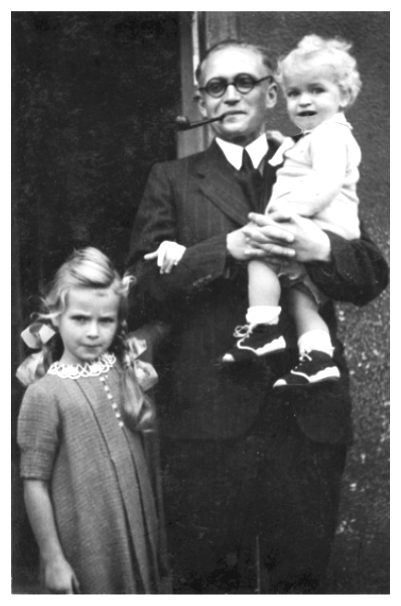
Dr. Thiel's development of the 25 ton rocket motor relied on pump feeding, rather than on the earlier pressure feeding. The motor used centrifugal injection, while using both regenerative cooling and film cooling. Film cooling admitted alcohol into the combustion chamber and exhaust nozzle under slight pressure through four rings of small perforations. The mushroom-shaped injection head was removed from the combustion chamber to a mixing chamber, the combustion chamber was made more spherical while being shortened from 6 to 1 foot in length, and the connection to the nozzle was made cone shaped. The resultant 1.5 ton chamber operated at a combustion pressure of 220 pounds per square inch. Thiel's 1.5 ton chamber was then scaled up to a 4.5 ton motor by arranging three injection heads above the combustion chamber. By 1939, eighteen injection heads in two concentric circles at the head of the 0.12-inch thick sheet-steel chamber, were used to make the 25 ton motor.
The warhead was another source of troubles. The explosive employed was amatol 60/40 detonated by an electric contact fuse. Amatol had the advantage of stability, and the warhead was protected by a thick layer of fiberglass, but even so it could still explode in the re-entry phase. The warhead weighed 975 kilograms (2,150 lb) and contained 910 kilograms (2,010 lb) of explosive. The warhead's percentage by weight that was explosive was 93%, a very high percentage when compared with other types of munitions.
In 1943 the Austrian resistance group around Heinrich Maier managed to send the exact drawings of the V2 rocket to the American Office of Strategic Services. Location sketches of V-rocket manufacturing facilities, such as those in Peenemünde, were also sent to Allied general staffs in order to enable Allied bombers to carry out air strikes. The group was gradually recognized by the Gestapo and most of the members were executed.

The protective layer was used for the fuel tanks as well and the A-4 did not have the tendency to form ice, which was common to other early missiles (like the balloon tank-design SM-65 Atlas). The tanks held 4,173 kilograms (9,200 lb) of ethyl alcohol and 5,553 kilograms (12,242 lb) of oxygen.
The A-4 used a 75% ethanol/25% water mixture (B-Stoff) for fuel and liquid oxygen (LOX) (A- Stoff) for oxidizer. The water reduced the flame temperature, acted as a coolant, tended to produce a smoother burn, and reduced thermal stress.
After the A-4 project was postponed due to unfavorable aerodynamic stability testing of the A-3 in July 1936, von Braun specified the A-4 performance in 1937, and, after an "extensive series of test firings of the A-5" scale test model, using a motor redesigned from the troublesome A-3 by Walter Thiel, A-4 design and construction was ordered c. 1938/39. During 28–30 September 1939, Der Tag der Weisheit (English: The Day of Wisdom) conference met at Peenemünde to initiate the funding of university research to solve rocket problems.
By late 1941, the Army Research Center at Peenemünde possessed the technologies essential to the success of the A-4. The four key technologies for the A-4 were large liquid-fuel rocket engines, supersonic aerodynamics, gyroscopic guidance and rudders in jet control. At the time, Adolf Hitler was not particularly impressed by the V-2; he pointed out that it was merely an artillery shell with a longer range and much higher cost.
In early September 1943, von Braun promised the Long-Range Bombardment Commission that the A-4 development was "practically complete/concluded," but even by the middle of 1944, a complete A-4 parts list was still unavailable.
Eight control surfaces were controlled by Helmut Hölzer's analog computer, the Mischgerät, via electrical-hydraulic servomotors, based on electrical signals from the gyros. The Siemens Vertikant LEV-3 guidance system consisted of two free gyroscopes (a horizontal for pitch and a vertical with two degrees of freedom for yaw and roll) for lateral stabilization, coupled with a PIGA accelerometer, or the Walter Wolman radio control system, to control engine cutoff at a specified velocity. Other gyroscopic systems used in the A-4 included Kreiselgeräte's SG-66 and SG-70.
The V-2s were launched from a pre-surveyed location, so the distance and azimuth to the target were known. Fin 1 of the missile was aligned to the target azimuth.
Some later V-2s used "guide beams", radio signals transmitted from the ground, to keep the missile on course, but the first models used a simple analog computer that adjusted the azimuth for the rocket, and the flying distance was controlled by the timing of the engine cut-off, "Brennschluss", ground controlled by a Doppler system or by different types of on-board integrating accelerometers. Thus, range was a function of engine burn time, which ended when a specific velocity was achieved. Just before engine cutoff, thrust was reduced to 8 tons, in an effort to avoid any water hammer problems a rapid cutoff could cause.
Dr. Friedrich Kirchstein of Siemens of Berlin developed the V-2 radio control for motor-cut-off (German: Brennschluss). For velocity measurement, Professor Wolman of Dresden created an alternative of his Doppler tracking system in 1940–41, which used a ground signal transponder by the A-4 to measure the velocity of the missile. By 9 February 1942, Peenemünde engineer Gerd deBeek had documented the radio interference area of a V-2 as 10,000 meters (33,000 feet) around the "Firing Point", and the first successful A-4 flight on 3 October 1942, used radio control for Brennschluss. Although Hitler commented on 22 September 1943 that "It is a great load off our minds that we have dispensed with the radio guiding-beam; now no opening remains for the British to interfere technically with the missile in flight", about 20% of the operational V-2 launches were beam-guided. The Operation Pinguin V-2 offensive began on 8 September 1944, when Lehr- und Versuchsbatterie No. 444 (English: Training and Testing Battery 444) launched a single rocket guided by a radio beam directed at Paris. Wreckage of combat V-2s occasionally contained the transponder for velocity and fuel cutoff.
The painting of the operational V-2s was mostly a ragged-edged pattern with several variations, but at the end of the war a plain olive green rocket also appeared. During tests the rocket was painted in a characteristic black-and-white chessboard pattern, which aided in determining if the rocket was spinning around its longitudinal axis.
The original German designation of the rocket was "V2", unhyphenated – exactly as used for any Third Reich-era "second prototype" example of an RLM-registered German aircraft design – but U.S. publications such as Life magazine were using the hyphenated form "V-2" as early as December 1944.
The first successful test flight was on 3 October 1942, reaching an altitude of 84.5 kilometers (52.5 miles). On that day Walter Dornberger declared in a speech at Peenemunde:
Two test launches were recovered by the Allies: the Bäckebo rocket, the remnants of which landed in Sweden on 13 June 1944, and one recovered by the Polish resistance on 30 May 1944 from Blizna and transported to the UK during Operation Most III. The highest altitude reached during the war was 174.6 kilometers (108.5 miles) (20 June 1944). Test launches of V-2 rockets were made at Peenemunde, Bizana and Tuchola Forest, and after the war, at Cuxhaven by the British, White Sands Proving Grounds and Cape Canaveral by the U.S., and Kapustin Yar by the USSR. Various design issues were then identified and solved during V-2 development and testing.

A production line was nearly ready at Peenemunde when the Operation Hydra attack occurred. The main targets of the attack included the test stands, the development works, the Pre-Production Works, the settlement where the scientists and technicians lived, the Trassenheide camp, and the harbor sector. According to Dornberger, "Serious damage to the works, contrary to first impressions, was surprisingly small." Work resumed after a delay of four to six weeks, and because of camouflage to mimic complete destruction, there were no more raids over the next nine months. The raid resulted in 735 lives lost, with heavy losses at Trassenheide, while 178 were killed in the settlement, including Dr. Thiel, his family, and Chief Engineer Walther. The Germans eventually moved production to the underground Mittelwerk in the Kohnstein where 5,200 V-2 rockets were built with the use of forced labor.
Following Operation Crossbow bombing, initial plans for launching from the massive underground Watten, Wizernes and Sottevast bunkers or from fixed pads such as near the Château du Molay were dropped in favor of mobile launching. Eight main storage dumps were planned and four had been completed by July 1944 (the one at Mery-sur-Oise was begun in August 1943 and completed by February 1944). The missile could be launched practically anywhere, roads running through forests being a particular favorite. The system was so mobile and small that only one Meillerwagen was ever caught in action by Allied aircraft, during the Operation Bodenplatte attack on 1 January 1945 near Lochem by a USAAF 4th Fighter Group aircraft, although Raymond Baxter described flying over a site during a launch and his wingman firing at the missile without hitting it.
It was estimated that a sustained rate of 350 V-2s could be launched per week, with 100 per day at maximum effort, given sufficient supply of the rockets.
After Hitler's 29 August 1944 declaration to begin V-2 attacks as soon as possible, the offensive began on 7 September 1944 when two were launched at Paris, but both crashed soon after launch. On 8 September a single rocket was launched at Paris, which caused modest damage near Porte d'Italie. Two more launches by the 485th followed, including one from The Hague against London on the same day at 6:43 pm. The first landed at Staveley Road, Chiswick, killing 63-year-old Mrs. Ada Harrison, 3-year-old Rosemary Clarke, and Sapper Bernard Browning on leave from the Royal Engineers, and one that hit Epping with no casualties. Upon hearing the double-crack of the supersonic rocket (London's first ever), Duncan Sandys and Reginald Victor Jones looked up from different parts of the city and exclaimed "That was a rocket!", and a short while after the double-crack, the sky was filled with the sound of a heavy body rushing through the air.
The British government initially attempted to conceal the cause of the explosions by blaming them on defective gas mains. The public therefore began referring to the V-2s as "flying gas pipes". The Germans themselves finally announced the V-2 on 8 November 1944 and only then, on 10 November 1944, did Winston Churchill inform Parliament, and the world, that England had been under rocket attack "for the last few weeks".
Positions of the German launch units changed a number of times. For example, Artillerie Init 444 arrived in the southwest Netherlands (in Zeeland) in September 1944. From a field near the village of Serooskerke, five V-2s were launched on 15 and 16 September, with one more successful and one failed launch on the 18th. That same date, a transport carrying a missile took a wrong turn and ended up in Serooskerke itself, giving a villager the opportunity to surreptitiously take some photographs of the weapon; these were smuggled to London by the Dutch Resistance. After that the unit moved to the woods near Rijs, Gaasterland in the northwest Netherlands, to ensure that the technology did not fall into Allied hands. From Gaasterland V-2s were launched against Ipswich and Norwich from 25 September (London being out of range). Because of their inaccuracy, these V-2s did not hit their target cities. Shortly after that only London and Antwerp remained as designated targets as ordered by Adolf Hitler himself, Antwerp being targeted in the period of 12 to 20 October, after which time the unit moved to The Hague.
Over the following months about 3,172 V-2 rockets were fired at the following targets:
Belgium, 1664: Antwerp (1610), Liège (27), Hasselt (13), Tournai (9), Mons (3), Diest (20 (2)
United Kingdom, 1,402: London (1,358), Norwich (43), Ipswich (1)
France, 76: Lille (25), Paris (22), Tourcoing (19), Arras (6), Cambrai (4)
Netherlands, 19: Maastricht (19)
Germany, 11: Remagen (11)
An estimated 2,754 civilians were killed in London by V-2 attacks with another 6,523 injured, which is two people killed per V-2 rocket. However, this understates the potential of the V-2, since many rockets were misdirected and exploded harmlessly. Accuracy increased over the course of the war, particularly for batteries where the Leitstrahl (radio guide beam) system was used. Missile strikes that found targets could cause large numbers of deaths – 168 were killed and 108 seriously injured in one explosion at 12:26 pm on 25 November 1944, at a Woolworth's department store in New Cross, south-east London.

British intelligence sent false reports via their Double-Cross System implying that the rockets were over-shooting their London target by 10 to 20 miles (16 to 32km). This tactic worked; more than half of the V-2s aimed at London landed outside the London Civil Defense Region. Most landed on less-heavily populated areas in Kent due to erroneous recalibration. For the remainder of the war, British intelligence kept up the ruse by repeatedly sending bogus reports implying that the rockets were now striking the British capital with heavy loss of life. r intelligence sent false reports via their Double-Cross System implying that the rockets were over-shooting their London target by 10 to 20 miles (16 to 32km). This tactic worked; more than half of the V-2s aimed at London landed outside the London ivil Defense Region. Most landed on less-heavily populated areas in Kent due to erroneous recalibration. For the remainder of the war, British intelligence kept up the ruse by repeatedly sending bogus reports implying that the rockets were now striking the British capital with heavy loss of life.
Antwerp, Belgium (below) was also the target for a large number of V-weapon attacks from October 1944 through March 1945, leaving 1,736 dead and 4,500 injured in greater Antwerp. Thousands of buildings were damaged or destroyed as the city was struck by 590 direct hits. The largest loss of life in a single attack came on 16 December 1944, when the roof of the crowded cinema Rex was struck, leaving 567 dead and 291 injured.
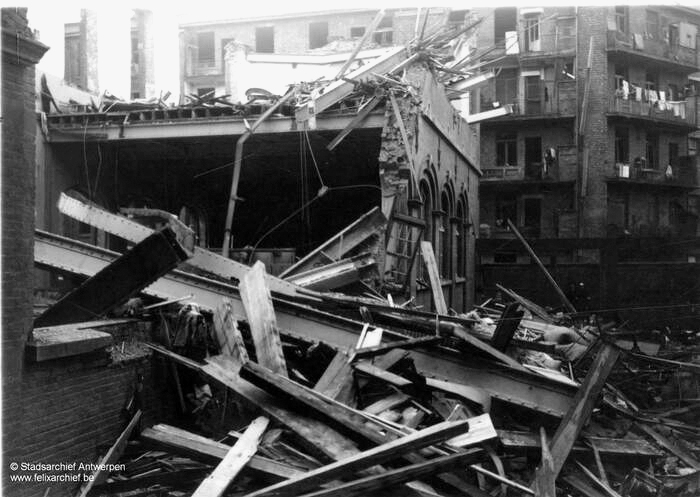

The final two rockets exploded on 27 March 1945. One of these was the last V-2 to kill a British civilian and the final civilian casualty of the war on British soil: Ivy Millichamp, aged 34, killed in her home in Kynaston Road, Orrington in Kent. A scientific reconstruction carried out in 2010 demonstrated that the V-2 creates a crater 20 meters (66 feet) wide and 8 meters (26 feet) deep, ejecting approximately 3,000 tons of material into the air. At Right: Antwerp Cinema Rex in 1944-1945
After the US Army captured the Ludendorff Bridge during the Battle of Remagen on March 7, 1945, the Germans were desperate to destroy it. On March 17, 1945, they fired eleven V-2s missiles at the bridge, their first use against a tactical target and the only time they were fired on a German target during the war. They could not employ the more accurate Leitstrahl devise because it was oriented towards Antwerp and could not be easily adjusted for another target. Fired from near Hellendoorn, the Netherlands, , one of the missiles landed as far away as Cologne, 40 miles (64 km) to the south, while one missed the bridge by only 500 to 800 yards (460 to 730 M). They also struck the town of Remagen, destroying a number of buildings and killing at least six American soldiers.
Unlike the V-1, the V-2's speed and trajectory made it practically invulnerable to anti-aircraft guns and fighters, as it dropped from an altitude of 100–110 km (62–68 mi) at up to three times the speed of sound at sea level (approximately 3550 km/h). Nevertheless, the threat of what was then code-named "Big Ben" was great enough that efforts were made to seek countermeasures. The situation was similar to the pre-war concerns about manned bombers and led to a similar solution, the formation of the Crossbow Committee, to collect, examine and develop countermeasures.
Early on, it was believed that the V-2 employed some form of radio guidance, a belief that persisted in spite of several rockets being examined without discovering anything like a radio receiver. This led to efforts to jam this non-existent guidance system as early as September 1944, using both ground and air-based jammers flying over the UK. In October, a group had been sent to jam the missiles during launch. By December it was clear these systems were having no obvious effect, and jamming efforts ended.
General Frederick Alfred Pile, commander of Anti-Aircraft Command, studied the problem and proposed that enough anti-aircraft guns were available to produce a barrage of fire in the rocket's path, but only if provided with a reasonable prediction of the trajectory. The first estimates suggested that 320,000 shells would have to be fired for each rocket. About 2% of these were expected to fall back to the ground, almost 90 tons of rounds, which would cause far more damage than the missile. At a 25 August 1944 meeting of the Crossbow Committee, the concept was rejected.
Pile continued studying the problem, and returned with a proposal to fire only 150 shells at a single rocket, with those shells using a new fuse that would greatly reduce the number that fell back to Earth unexploded. Some low-level analysis suggested that this would be successful against 1 in 50 rockets, provided that accurate trajectories were forwarded to the gunners in time. Work on this basic concept continued and developed into a plan to deploy a large number of guns in Hyde Park that were provided with pre-configured firing data for 2.5-mile (4.0-kilometer) grids of the London area. After the trajectory was determined, the guns would aim and fire between 60 and 500 rounds.
At a Crossbow meeting on 15 January 1945 Pile's updated plan was presented with some strong advocacy from Roderick Hill and Charles Drummond Ellis. However, the Committee suggested that a test not be carried out as no technique for tracking the missiles with sufficient accuracy had yet been developed. By March this had changed significantly, with 81% of incoming missiles correctly allotted to the grid square each fell into, or the one beside it. At a 26 March meeting the plan moved ahead, and Pile was directed to a subcommittee with RV Jones and Ellis to further develop the statistics. Three days later the team returned a report stating that if the guns fired 2,000 rounds at a missile there was a 1 in 60 chance of shooting it down. Plans for an operational test began, but as Pile later put it, "Monty beat us to it", as the attacks ended with the Allied liberation of their launching areas.
With the Germans no longer in control of any part of the continent that could be used as a launching site capable of striking London, they turned their attention to Antwerp. Plans were made to move the Pile system to protect that city, but the war ended before anything could be done.
The only effective defense against the V-2 campaign was to destroy the launch infrastructure—expensive in terms of bomber resources and casualties—or to cause the Germans to aim at the wrong place through disinformation. The British were able to convince the Germans to direct V-1s and V-2s aimed at London to less populated areas east of the city. This was done by sending deceptive reports on the damage caused and sites hit via the German espionage network in Britain, which was controlled by the British (the Double-Cross System).
According to the BBC television presenter Raymond Baxter, who served with the RAF during the war, in February 1945 his squadron was carrying out a mission against a V2 launch site, when one missile was launched in front of them. One member of Baxter's squadron opened fire on it, without effect.
On 3 March 1945 the Allies attempted to destroy V-2s and launching equipment in the "Haagse Bos" in The Hague by a large-scale bombardment, but due to navigational errors the Bezuidenhout quarter was destroyed, killing 511 Dutch civilians. Churchill sent a scathing minute to General Ismay requesting a thorough explanation for "this extraordinarily bad aiming".
The German V-weapons (V-1 and V-2) cost the equivalent of around US$40 billion (2015 dollars), which was 50 percent more than the Manhattan Project that produced the atomic bomb. 6,048 V-2s were built, at a cost of approximately 100,000 Reichsmark (GB£2,370,000 (2011) each; 3,225 were launched. SS General Hans Kammler, who as an engineer had constructed several concentration camps including Auschwitz, had a reputation for brutality and had originated the idea of using concentration camp prisoners as slave laborers in the rocket program. More people died manufacturing the V-2 than were killed by its deployment.
"... those of us who were seriously engaged in the war were very grateful to Werner von Braun. We knew that each V-2 cost as much to produce as a high-performance fighter airplane. We knew that German forces on the fighting fronts were in desperate need of airplanes, and that the V-2 rockets were doing us no military damage. From our point of view, the V-2 program was almost as good as if Hitler had adopted a policy of unilateral disarmament." (Freeman Dyson)
The V-2 consumed a third of Germany's fuel alcohol production and major portions of other critical technologies: to distil the fuel alcohol for one V-2 launch required 30 tones of potatoes at a time when food was becoming scarce. Due to a lack of explosives, some warheads were simply filled in with concrete, using the kinetic energy alone for destruction, and sometimes the warhead contained photographic propaganda of German citizens who had died in Allied bombings.
The psychological effect of the V-2 was considerable, as the V-2, travelling faster than the speed "of sound, gave no warning before impact (unlike bombing planes or the V-1 Flying Bomb, which made a characteristic buzzing sound). There was no effective defense and no risk of pilot and crew casualties. An example of the impression it made is in the reaction of American pilot and future nuclear strategist and Congressional aide William Liscum Borden, who in November 1944 while returning from a nighttime mission over Holland saw a V-2 in flight on its way to strike London: It resembled a meteor, streaming red sparks and whizzing past us as though the aircraft were motionless. I became convinced that it was only a matter of time until rockets would expose the United States to direct, transoceanic attack."
With the war all but lost, regardless of the factory output of conventional weapons, the Nazis resorted to V-weapons as a tenuous last hope to influence the war militarily (hence Antwerp as V-2 target), as an extension of their desire to "punish" their foes and most importantly to give hope to their supporters with their miracle weapon. The V-2 had no effect on the outcome of the war, but it led to the ICBMs of the Cold War, which in turn were used for space exploration.
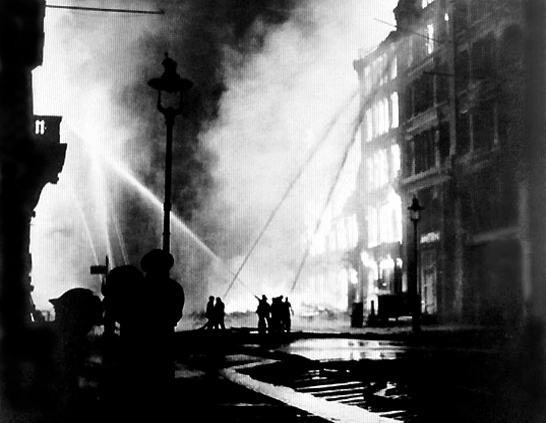 |
 |
 |
 |
 |
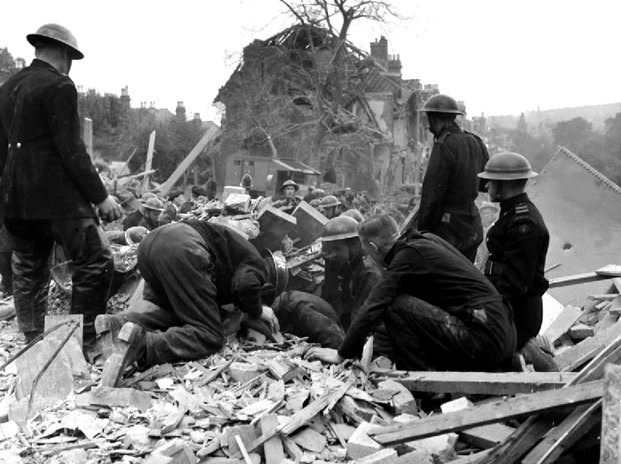 |
The London Blitz, 1940
The appearance of German bombers in the skies over London during the afternoon of September 7, 1940 heralded a tactical shift in Hitler's attempt to subdue England. During the previous two months, the Luftwaffe had targeted RAF airfields and radar stations for destruction in preparation for the German invasion of the island. With invasion plans put on hold and eventually scrapped, Hitler turned his attention to destroying London in an attempt to demoralize the population and force England to come to terms. At around 4:00 PM on that September day, 348 German bombers escorted by 617 fighters blasted London until 6:00 PM. Two hours later, guided by the fires set by the first assault, a second group of raiders commenced another attack that lasted until 4:30am the following morning.
This was the beginning of the Blitz - a period of intense bombing of London and other cities that continued until the following May. For the next consecutive 57 days, London was bombed either during the day or at night. Fires consumed many portions of the city. Residents sought shelter wherever they could find it - many fleeing to the Underground stations that sheltered as many as 177,000 people during the night. In the worst single incident, 450 were killed when a bomb destroyed a school being used as an air raid shelter. Londoners and the world were introduced to a new weapon of terror and destruction in the arsenal of twentieth century warfare. The Blitz ended on May 11, 1941 when Hitler called off the raids in order to move his bombers east in preparation for Germany's invasion of Russia.
"They came just after dark... " Ernie Pyle wrote who was one of World War Two's most popular correspondents. His journalism was characterized by a focus on the common soldier interspersed with sympathy, sensitivity and humor. He witnessed the war in Europe from the Battle of Britain through the invasion of France. In 1945 he accepted assignment to the Pacific Theater and was killed during the battle for Okinawa. Here, he describes a night raid on London in 1940:
"It was a night when London was ringed and stabbed with fire. They came just after dark, and somehow you could sense from the quick, bitter firing of the guns that there was to he no monkey business this night.:
Shortly after the sirens wailed you could hear the Germans grinding overhead. In my room, with its black curtains drawn across the windows, you could feel the shake from the guns. You could hear the boom, crump, crump, crump, of heavy bombs at their work of tearing buildings apart. They were not too far away.:
Half an hour after the firing started I gathered a couple of friends and went to a high, darkened balcony that gave us a view of a third of the entire circle of London. As we stepped out onto the balcony a vast inner excitement came over all of us - an excitement that had neither fear nor horror in it, because it was too full of awe.:
You have all seen big fires, but I doubt if you have ever seen the whole horizon of a city lined with great fires - scores of them, perhaps hundreds.:
There was something inspiring just in the awful savagery of it. The closest fires were near enough for us to hear the crackling flames and the yells of firemen. Little fires grew into big ones even as we watched. Big fires died down under the firemen's valor, only to break out again later.:
About every two minutes a new wave of planes would be over. The motors seemed to grind rather than roar, and to have an angry pulsation, like a bee buzzing in blind fury.:
The guns did not make a constant overwhelming din as in those terrible days of September. They were intermittent - sometimes a few seconds apart, sometimes a minute or more. Their sound was sharp, near by; and soft and muffled, far away. They were everywhere over London.:
Into the dark shadowed spaces below us, while we watched, whole batches of incendiary bombs fell. We saw two dozen go off in two seconds. They flashed terrifically, then quickly simmered down to pin points of dazzling white, burning ferociously. These white pin points would go out one by one, as the unseen heroes of the moment smothered them with sand. But also, while we watched, other pin points would burn on, and soon a yellow flame would leap up from the white center. They had done their work - another building was on fire.:
The greatest of all the fires was directly in front of us. Flames seemed to whip hundreds of feet into the air. Pinkish-white smoke ballooned upward in a great cloud, and out of this cloud there gradually took shape - so faintly at first that we weren't sure we saw correctly - the gigantic dome of St. Paul's Cathedral.:
St. Paul's was surrounded by fire, but it came through. It stood there in its enormous proportions - growing slowly clearer and clearer, the way objects take shape at dawn. It was like a picture of some miraculous figure that appears before peace-hungry soldiers on a battlefield. The streets below us were semi-illuminated from the glow. Immediately above the fires the sky was red and angry, and overhead, making a ceiling in the vast heavens, there was a cloud of smoke all in pink. Up in that pink shrouding there were tiny, brilliant specks of flashing light-antiaircraft shells bursting. After the flash you could hear the sound.:
Up there, too, the barrage balloons were standing out as clearly as if it were daytime, but now they were pink instead of silver. And now and then through a hole in that pink shroud there twinkled incongruously a permanent, genuine star - the old - fashioned kind that has always been there.:
Below us the Thames grew lighter, and all around below were the shadows - the dark shadows of buildings and bridges that formed the base of this dreadful masterpiece.:
Later on I borrowed a tin hat and went out among the fires. That was exciting too; but the thing I shall always remember above all the other things in my life is the monstrous loveliness of that one single view of London on a holiday night - London stabbed with great fires, shaken by explosions, its dark regions along the Thames sparkling with the pin points of white-hot bombs, all of it roofed over with a ceiling of pink that held bursting shells, balloons, flares and the grind of vicious engines. And in yourself the excitement and anticipation and wonder in your soul that this could be happening at all.:
These things all went together to make the most hateful, most beautiful single scene I have ever known."
Johnson, David, The London Blitz: The City Ablaze, December 29,
1940
(1981); Ernie Pyle in England (1941), Reprinted in Commager,
Henry Steele, The Story of the Second World War (1945).
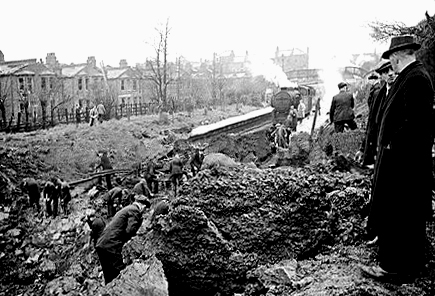 |
 |
 |
 |
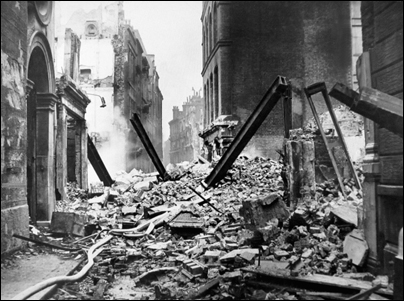 |
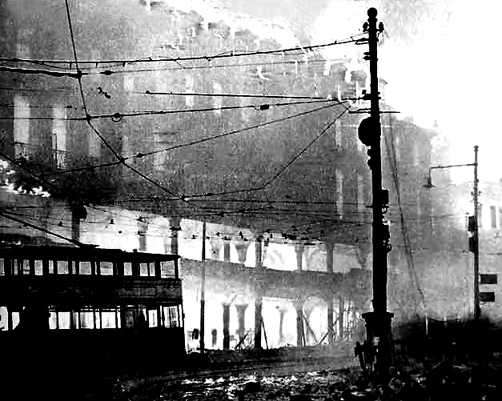 |
 |
 |
 |
 |
 |
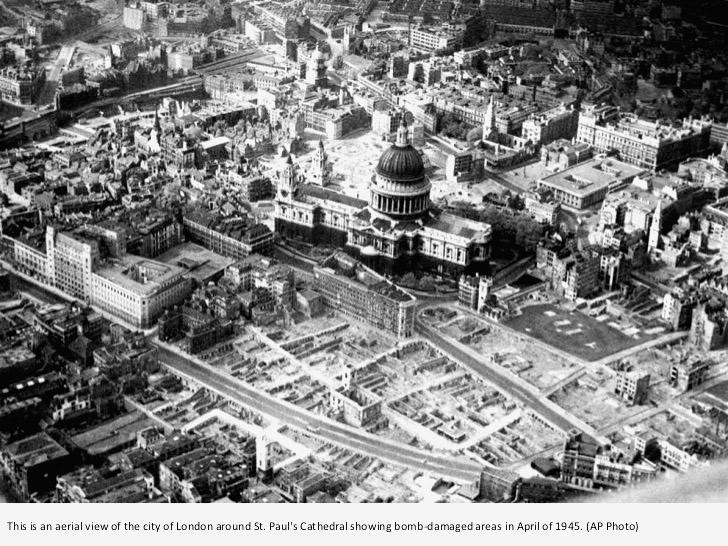 |
 600 Children Killed |
 |
 |
 |
